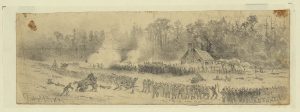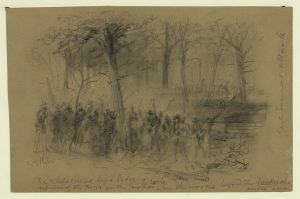Jubal Early’s Charmed Existence in the Summer of 1862
ECW welcomes guest author Chris Bryan

Brigadier General Jubal Early, and his brigade, faced tight spots on numerous battlefields in August and September 1862. These events occurred during a period when the brigade also fought at Kettle Run, Groveton, and Second Manassas. In two of these tight spots, the fate of the Confederate army with which Early fought arguably stood in the balance. Early’s brigade survived each situation thanks to varying combinations of level headedness on Early’s part and a favorable change in circumstances.
Major General Richard Stoddert Ewell’s division, to which Early belonged, left the York-James peninsula in mid-July 1862. It accompanied Stonewall Jackson’s division, arriving at Gordonsville on July 15th. Jackson’s command shifted to this region in order to guard the Virginia Central Railroad from three Union corps that had just gathered. On June 26, these corps, under Major Generals Nathaniel Banks, Irwin McDowell, and Franz Sigel, had joined organizationally into the new Union Army of Virginia under Major General John Pope. Brigadier General Ambrose Powell Hill’s division joined Jackson on the 30th. With Hill’s arrival, Jackson could transition to seeking offensive opportunities against an isolated portion of Pope’s army.[1]
Jackson’s opportunity came when a portion of Nathaniel Banks’ II Corps occupied Culpeper Court House far ahead of Pope’s main line, which stretched from Sperryville to Waterloo Bridge on the Rappahannock River. The Union presence at Culpeper Court House had built steadily since the second week in July. A full infantry brigade was in place by the 24th. On August 6, the balance of Banks’ corps marched toward Culpeper. Learning that only part of Pope’s army was at Culpeper Court House, Jackson marched on the 7th, but a stifling heat wave and a miscommunicated marching order, caused Jackson’s army to fall short of his intended mileage on the 8th.[2]
Banks’ small corps reached the battlefield between Cedar Run and Slaughter’s Mountain, south of Culpeper, by midday August 9th. By then, Jackson still had one division on the road. When Banks impetuously attacked, a single brigade drove through Jackson’s left center, engaged in a desperate hand to hand fight in the woods, and exited the woods, turning the flank of two more of Jackson’s brigades. This left Jackson with the Stonewall Brigade on his far left and less than half of Early’s brigade and Brigadier General Edward Thomas’ brigade on his center right. All the units in between fell back; many were disordered. Two additional brigades were farther right, on the mountain and out of supporting distance. Jackson faced a serious challenge, with the outcome in doubt for a time.[3]

While half of Early’s line peeled away under fire from its left rear, Early was beyond the right of his brigade on lower ground placing Thomas’ brigade, the first brigade to arrive from A. P. Hill’s division. When Early returned, an unsettling sight greeted him. Beyond the left of his three rightmost regiments, no Confederates were visible in the open ground to the woods, half a mile away. One of these remaining regiments, the 58th Virginia, had partially retreated, as well. The 52nd Virginia started the day with only four companies. On Early’s right, the 12th Georgia was his only full regiment.[4]
With these regiments and Thomas’ brigade, Early maintained contact with Brigadier General Henry Prince’s Federal Brigade in his front. Dispatching his Assistant Adjutant General to rally fleeing regiments, Early directed the regimental commanders to “hold onto their positions at all hazards.” Low on ammunition, Captain William Brown, commanding the 12th Georgia, asked Early whether they should charge. Early declined the spirited suggestion. Good fortune rapidly intervened as the dust rising above the road to Orange Court House materialized into the balance of Hill’s division, which plugged the hole and drove Banks’ right and center.[5]
A week later, much of Robert E. Lee’s army joined Jackson on the Rapidan. Pope had escaped across the Rappahannock. Over the next five days, Lee tried turning Pope’s right flank to cross the river. Pope mostly mirrored Lee’s upstream movements while maintaining contact with Army of the Potomac reinforcements coming from Fredericksburg.[6]
On the 22nd, as Jeb Stuart’s cavalry raided Pope’s baggage train at Catlett’s Station, Lee’s vanguard found an open crossing at Fauquier White Sulphur Springs. Late in the day, Ewell ordered Early’s and Lawton’s brigades to cross. Lawton’s 13th Georgia and two four-gun batteries successfully crossed at the Springs; Early’s brigade crossed on an old dam one mile south. While crossing, an intense thunderstorm broke. A freshet crested well above the Rappahannock’s banks and swept away all man-made crossings except the railroad bridge at Rappahannock Station. Early was trapped on the north bank with three Union corps.[7]
Early had factors in his favor. The storm, which Confederate Captain Charles Blackford wrote caused that night to be “as dark as blackness itself,” concealed Early’s position from Federal cavalry the first night as his men concealed themselves in a pine stand. A Federal cavalryman approached one of the batteries and was killed. Early’s detachment expected that they faced imminent capture. Early also benefited from anemic advances by Pope’s two forward corps under Major Generals Franz Sigel and Irwin McDowell. Pope’s staffer, Colonel T.C.H. Smith blamed Sigel, citing “his usual record.”[8]
Moreover, two distractions occurred during the first twelve hours for the General Commanding. First, the scope and meaning of Stuart’s raid on Catlett’s Station was initially unclear. Second, Major General James Longstreet opened a massive artillery duel at Rappahannock Station and Beverly Ford at sunrise on the 23rd. This action, which Longstreet initiated to create room to disengage and sidle upriver, stood out amidst a week of near-constant artillery combat. Though the high river caused Pope to abandon thoughts of crossing the river himself, he could not be sure of Longstreet’s intentions, especially as Confederate infantry advanced against a Federal-occupied tête de pont, or fortification, near the bridge on the south bank.[9]
Regardless of external circumstances, Early managed his poor hand effectively. He positioned the 13th and 31st Virginia facing east on Great Run, a swollen stream feeding the Rappahannock. They fronted Sigel’s advance. The rest of the command, including the artillery, were 1200 yards away, on a hill near Sulphur Springs facing north, toward Warrenton. All remained concealed in woodlots. By early afternoon on the 24th, with Great Run fordable, Early discovered McDowell advancing toward Warrenton from the east; then Sigel’s vanguard joined the Federal cavalry that had hovered across Great Run all morning. As Early’s infantry changed front within the woods to face Sigel, his batteries kept moving, engaging from multiple points in order to give the Federals an outsized impression. Soon, part of Stuart’s cavalry, with one artillery section, arrived from Catlett’s to support Early. By sunset, engineers and volunteers from A.P. Hill’s division reconstructed a makeshift bridge. The detachment crossed at dawn after a night audible with Federal forces gathering around it.[10]
Nearly one month later, at Antietam, Early found himself with the only fresh brigade on the Confederate left. Up to that point, about 8:30 a.m. on September 17, all three divisions on the left had fought and fallen back. Three brigades of Major General D. H. Hill’s division from the center had done the same. These were falling back from the D. R. Miller cornfield when Early arrived in the West Woods beside about 300 men remaining from Jackson’s former division. Two brigades of Federals approached from the north toward Early’s left. Three companies of a large, new regiment, the 124th Pennsylvania, were west of the Hagerstown Pike, facing Early’s right. The remainder of that regiment was east of the Pike heading south, further threatening his flank. Soon, Early discovered that the battery firing in his right rear was Federal and that two brigades under Brigadier General George Sears Greene were gathering near it. Finally, another inexperienced regiment larger than his brigade, the 125th Pennsylvania, entered the woods behind him at the Dunker Church. Early could no longer remain still.[11]

Leaving Jackson’s division and one of his own regiments facing north, Early moved through the woods by the right flank, descending into low ground near the A. Poffenberger farm. Using outcroppings for concealment, Early’s men paralleled the Pennsylvanians’ path, then fronted east, fired two volleys and went after the Pennsylvanians at the top of the hill. However, Early disordered the brigade by directing a series of advances and withdrawals. Asked why, Early answered that he intended to throw off the range of Federal battery fire. He soon withdrew from this engagement, making way for reinforcements. Without them, one of Early’s fronts would likely have collapsed. His brigade immediately joined an attack on a new threat to the north. Though Early’s engagement with the 125th Pennsylvania was awkward, he faced a near-run situation and bought time for his brigade and the army.[12]
While Early’s near calamitous episodes in the summer of 1862 were not unique for brigades in either army, such a string of close calls over a short period is noteworthy. Surviving the first two, especially the real threat of capture on the Rappahannock, allowed the brigade to maintain a foothold in the West Woods. While the 125th Pennsylvania was not likely to progress beyond its perch near the Dunker Church on its own, other inbound Union forces could have. Had Early’s brigade been absent, it does not mean that another could not have likewise bought time in the West Woods. Events may have unfolded in any number of different ways, but the Army of Northern Virginia would have been down a brigade on a day when it had none to spare. In any event, Early’s cool management of each of these situations would not have mattered without his circumstances improving just in time. Early should have considered himself quite fortunate in the late summer of 1862.
————
Chris Bryan received his Bachelor of Science degree in History from the United States Naval Academy. He is currently working towards his Master’s degree in Historic Preservation from the University of Maryland. Chris is publishing a book with Savas Beatie titled, Resurgent Stars: Banks’ Corps from Slaughter’s Mountain to the Dunker Church.
[1] OR 12, Pt. 2, 20; OR 12, Pt. 3, 915, 919, 926; Jubal Anderson Early, Autobiographical Sketch and Narrative of the War Between the States (Philadelphia, 1912), 92; John S. Clark to Nathaniel Banks, July 31, 1862, Nathaniel Banks Papers, Library of Congress.
[2] OR 12, Pt. 2, 21, 182, 214-217; Pt. 3, 535, 926; Washington Hicks, Diary, Chandler B. Gillam Papers, Library of Congress
[3] OR 12, Pt. 2, 146-147, 183
[4] OR 12, Pt. 2, 231.
[5] Early, Autobiographical Sketch, 98-99.
[6] OR 12, Pt. 2, 29-30, 552-553.
[7] OR, 12, Pt. 2, 31, 705.
[8] Blackford, Letters, 122-123; Kelly, 36; Thomas Church Haskell Smith, Papers, MSS 158, Ohio History Connection, Part 3, 103.
[9] OR 12, Pt. 2, 331, 564.
[10] OR 12, Pt. 2, 650, 705-706, 732; Early, Autobiographical Sketch, 108-111; Kelley, Scharf Memoirs, 36.
[11] Early, Autobiographical Sketch, 142-146; Ezra Carman, Maryland Campaign of September 1862, Vol. 2: Antietam, ed. Thomas G. Clemens (El Dorado Hills, CA, 2012), 157, 179; Jonathan Gibson to Ezra Carman, September 6, 1899, National Archives Records Administration, Record Group 94 – Antietam Studies (NA-AS).
[12] OR 19, Pt. 1, 971; Early, Autobiographical Sketch, 146-147; Jonathan Gibson to Ezra Carman, September 6, 1899 and June 21, 1901, NA-AS.
1 Response to Jubal Early’s Charmed Existence in the Summer of 1862